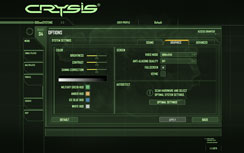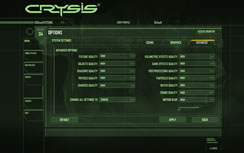Sapphire Radeon HD 3870 512MB Atomic
Written by Tim Smalley
February 4, 2008 | 12:43
Tags: #3870 #article #atomic #card #evaluation #hd #overclocked #overclocking #performance #radeon #review #rv670

Crysis
Publisher: Electronic ArtsWhat can we say about this game that hasn’t been said already? Crysis is probably the most anticipated game on the PC last year and was released on November 16th 2007.
Crysis is seen by many as the poster boy for DirectX 10 and it will make your system cry, quite literally – it’s a monster! It doesn’t come as much of a surprise then, that the graphics are something special – they’re above and beyond anything we’ve ever seen in a PC game.
We tested the game under both DirectX 9.0 and DirectX 10 with the 1.1 patch applied. We used a custom timedemo recorded on the Island map which is more representative of gameplay than the built-in benchmark that renders things much faster than you’re going to experience in game. We found that around 25-30 fps in our timedemo was sufficient enough to obtain a playable frame rate through the game. It’s a little different to other games in that the low frame rates still appear to be quite smooth.
For our testing under DirectX 9.0, we set all of the in-game settings to high, while we set shader quality and water quality to 'very high' for DirectX 10 -- all other settings remained the same as what they were set to for our DX9 performance testing. Because of how intense the game is, we tested with both anti-aliasing and anisotropic filtering disabled at resolutions above 1280x1024 for the time being. There is currently no support for anisotropic filtering in the game, but you can still force it from the driver control panel.
DirectX 9.0
Crysis
1280x1024 2xAA 0xAF, High Quality, DirectX 9.0
- Nvidia GeForce 8800 Ultra 768MB
- BFGTech GeForce 8800 GTS 512MB OC
- ATI Radeon HD 3870 X2 1GB
- Nvidia GeForce 8800 GTS 512MB
- ATI Radeon HD 3870 X2 512MB CrossFire
- Nvidia GeForce 8800 GTX 768MB
- Nvidia GeForce 8800 GT 512MB
- Sapphire Radeon HD 3870 512MB ATOMIC
- ATI Radeon HD 3870 512MB
-
-
37.0
-
28.0
-
-
-
35.9
-
25.0
-
-
-
35.1
-
24.0
-
-
-
35.1
-
24.0
-
-
-
35.1
-
23.0
-
-
-
33.6
-
25.0
-
-
-
31.6
-
22.0
-
-
-
23.6
-
16.0
-
-
-
22.2
-
15.0
-
0
10
20
30
40
Frames Per Second
-
Average
-
Minimum
Crysis
1680x1050 0xAA 0xAF, High Quality, DirectX 9.0
- ATI Radeon HD 3870 X2 512MB CrossFire
- ATI Radeon HD 3870 X2 1GB
- Nvidia GeForce 8800 Ultra 768MB
- BFGTech GeForce 8800 GTS 512MB OC
- Nvidia GeForce 8800 GTS 512MB
- Nvidia GeForce 8800 GTX 768MB
- Nvidia GeForce 8800 GT 512MB
- Sapphire Radeon HD 3870 512MB ATOMIC
- ATI Radeon HD 3870 512MB
-
-
37.5
-
25.0
-
-
-
37.1
-
26.0
-
-
-
35.1
-
24.0
-
-
-
35.0
-
24.0
-
-
-
34.3
-
23.0
-
-
-
32.2
-
21.0
-
-
-
30.5
-
20.0
-
-
-
26.2
-
18.0
-
-
-
25.1
-
17.0
-
0
10
20
30
40
Frames Per Second
-
Average
-
Minimum
Crysis
1920x1200 0xAA 0xAF, High Quality, DirectX 9.0
- ATI Radeon HD 3870 X2 512MB CrossFire
- ATI Radeon HD 3870 X2 1GB
- Nvidia GeForce 8800 Ultra 768MB
- BFGTech GeForce 8800 GTS 512MB OC
- Nvidia GeForce 8800 GTS 512MB
- Nvidia GeForce 8800 GTX 768MB
- Nvidia GeForce 8800 GT 512MB
- Sapphire Radeon HD 3870 512MB ATOMIC
- ATI Radeon HD 3870 512MB
-
-
32.3
-
21.0
-
-
-
31.9
-
21.0
-
-
-
29.7
-
19.0
-
-
-
29.0
-
19.0
-
-
-
28.4
-
18.0
-
-
-
26.1
-
17.0
-
-
-
25.2
-
16.0
-
-
-
22.1
-
14.0
-
-
-
20.8
-
12.0
-
0
5
10
15
20
25
30
35
Frames Per Second
-
Average
-
Minimum
DirectX 10
Crysis
1280x1024 2xAA 0xAF, Very High Water/Shaders, all others High, DirectX 10
- ATI Radeon HD 3870 X2 512MB CrossFire
- ATI Radeon HD 3870 X2 1GB
- Nvidia GeForce 8800 Ultra 768MB
- BFGTech GeForce 8800 GTS 512MB OC
- Nvidia GeForce 8800 GTX 768MB
- Nvidia GeForce 8800 GTS 512MB
- Nvidia GeForce 8800 GT 512MB
- Sapphire Radeon HD 3870 512MB ATOMIC
- ATI Radeon HD 3870 512MB
-
-
34.5
-
21.0
-
-
-
33.7
-
20.0
-
-
-
32.6
-
23.0
-
-
-
29.7
-
20.0
-
-
-
29.7
-
21.0
-
-
-
29.2
-
20.0
-
-
-
26.5
-
18.0
-
-
-
23.5
-
14.0
-
-
-
22.2
-
13.0
-
0
5
10
15
20
25
30
35
Frames Per Second
-
Average
-
Minimum
Crysis
1680x1050 0xAA 0xAF, Very High Water/Shaders, all others High, DirectX 10
- ATI Radeon HD 3870 X2 512MB CrossFire
- ATI Radeon HD 3870 X2 1GB
- Nvidia GeForce 8800 Ultra 768MB
- BFGTech GeForce 8800 GTS 512MB OC
- Nvidia GeForce 8800 GTX 768MB
- Nvidia GeForce 8800 GTS 512MB
- Nvidia GeForce 8800 GT 512MB
- Sapphire Radeon HD 3870 512MB ATOMIC
- ATI Radeon HD 3870 512MB
-
-
33.8
-
21.0
-
-
-
32.8
-
14.0
-
-
-
30.3
-
19.0
-
-
-
28.1
-
19.0
-
-
-
27.8
-
17.0
-
-
-
27.6
-
18.0
-
-
-
24.5
-
16.0
-
-
-
22.6
-
14.0
-
-
-
21.2
-
12.0
-
0
5
10
15
20
25
30
35
Frames Per Second
-
Average
-
Minimum
Crysis
1920x1200 0xAA 0xAF, Very High Water/Shaders, all others High, DirectX 10
- ATI Radeon HD 3870 X2 512MB CrossFire
- ATI Radeon HD 3870 X2 1GB
- Nvidia GeForce 8800 Ultra 768MB
- BFGTech GeForce 8800 GTS 512MB OC
- Nvidia GeForce 8800 GTS 512MB
- Nvidia GeForce 8800 GTX 768MB
- Nvidia GeForce 8800 GT 512MB
- Sapphire Radeon HD 3870 512MB ATOMIC
- ATI Radeon HD 3870 512MB
-
-
27.5
-
20.0
-
-
-
26.4
-
14.0
-
-
-
24.5
-
15.0
-
-
-
23.2
-
15.0
-
-
-
22.8
-
15.0
-
-
-
22.4
-
14.0
-
-
-
20.2
-
13.0
-
-
-
18.9
-
11.0
-
-
-
17.9
-
11.0
-
0
5
10
15
20
25
30
Frames Per Second
-
Average
-
Minimum
Crysis showed Sapphire's Radeon HD 3870 512MB Atomic Edition to be a little faster than the standard Radeon HD 3870, but the difference wasn't massive. Under DirectX 9.0, the card didn't really give Nvidia's GeForce 8800 GT a run for its money, never mind the slightly more expensive GeForce 8800 GTS 512MB.
Under DirectX 10 though, both the standard and factory-overclocked Radeon HD 3870 cards managed to catch up with the GeForce 8800 GT, although neither was fast enough to outpace it in the performance stakes. One thing that's worth noting here is that, in the run up to testing the Radeon HD 3870 X2, we found that there were some performance problems with the standard clocked Radeon HD 3870 512MB at 1280x1024 – these weren't present when we tested the Sapphire Radeon HD 3870 Atomic, so we felt it necessary to re-test the reference 3870.
Thankfully, the card performed properly this time around – we're not quite sure what happened when we tested before because performance was consistently poor. I'm guessing some freak disagreement somewhere down in the deepest depths of Vista... I guess it's not hard to disagree with yourself when your name's Windows Vista.











Want to comment? Please log in.